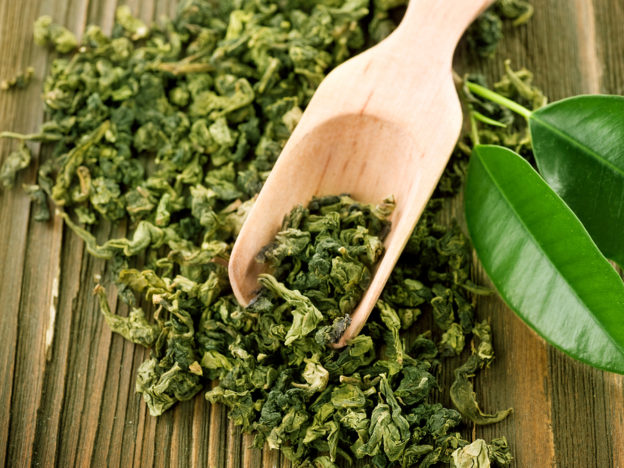By David Blyweiss, M.D., Advanced Natural Wellness
June 29, 2018
- Are healthy food choices overwhelming you?
- 8 super healthy foods you should eat every day
- Top everything with this… and don’t forget your beverage!
Eating a nutrient-rich diet is one of the best things you can do to increase your chances of a long and healthy life. But trying to figure out what to eat can be overwhelming. In fact, patients often ask me if there are certain foods they should be eating more of.
This is a great question. And I’ll share with you the same answer I give my patients.
There are eight nutrition-packed foods that I feel everyone should be eating more of, every single day. They aren’t weird or exotic… and you can easily pick them up at your local market when you do your shopping.
8 Super Healthy Foods you should eat Every Day
#1 – Green leafy vegetables like lettuce, kale, spinach, collard greens and turnip greens should grace your plate at least twice a day. These green foods are rich in vitamins K1, A, C, E and many of the B vitamins. They also provide minerals like magnesium, potassium, iron and calcium. And they’re chock full of fiber, folate and antioxidants.
Eating greens regularly can protect against cardiovascular disease, boost your immune system, enhance your bone health, slow down mental decline and protect against all types of cancer. I suggest eating at least two servings of leafy greens every day.
#2 – Vegetables of all colors of the rainbow should also be a big part of your diet. Tomatoes, rutabagas, broccoli, squash, cauliflower, carrots, avocadoes, sweet potatoes and other veggies all have a place at your dinner table. So in addition to your leafy greens, it’s a good idea to eat two servings of other colorful vegetables each day.
#3 – Organic berries are one of my favorite treats. Not only are they tasty, they also contain a wealth of anti-inflammatory flavonoids and anthocyanins.
MD Exposes the Hidden Danger to Your Eyes

When your eyesight starts to fail, it's a real problem. Suddenly you can't go to the grocery store... you can't get to the doctor if you have an emergency... you can't meet your friends for dinner…
Your "regular" doctor doesn't have time to keep up with the latest research. And the same goes for eye doctors. They go to school to learn how to fit you for glasses and contacts, but have no way of preventing the damage and loss of eyesight that threatens your freedom and independence.
Let me show you something that explains a LOT about how your eyes work.
In my FREE Special Report, I'll show you a HUGE, untapped resource for your eyes that safely and naturally restores clear, effortless eyesight.
Click here to get started...
People who eat berries every day have brains that are about 2.5 years younger than people who don’t. Plus, I like the fact that berries can help reduce plaque in your arteries, lower blood pressure and potentially reduce your risk of a heart attack by about 33%. They also help keep cancer from invading your cells and spreading through your body.
It doesn’t take a lot of berries to get all of these amazing health benefits. Just one serving a day – about a half of cup – is all it takes.
#4 – Other fruits are just as important to your overall health. This includes things like apples, bananas, melons, mangos, citrus fruits… mix them up and enjoy 1.5 to 2 cups of fruit (in addition to your berries) each day.
#5 – Tree nuts are best known for their heart-healthy benefits. They improve blood pressure and endothelial function, reduce inflammation, protect against the development of type 2 diabetes, help you maintain a healthy body weight and support a healthy gut microbiota. Additionally, recent data shows that eating more nuts may help ward off numerous types of cancer.
A nice thing about nuts is that a little bit goes a long way. It only takes about 1.5 ounces of them each day to gain all of this protection. (This is the equivalent of about 12 Brazil nuts or 21 walnut halves. It takes around 25 cashews to make 1.5 ounces, or 36 almonds.)
#6 – Beans/Legumes are loaded with protein and health-giving nutrients like potassium, magnesium, folate, iron and zinc. They’re also a great source of soluble fiber, which is sorely lacking in today’s American diet. If you have any concerns about their lectin content, cooking them very well will take care of that.
Because of the high fiber content, beans are absorbed very slowly by your body. This is great for your sugar metabolism, because the slow absorption rate helps prevent glucose and insulin spikes. Beans also reduce inflammatory markers (CRP, IL-6) linked to heart disease. So they really are good for your heart!
I recommend getting, at minimum, one serving of beans and legumes a day. (That’s about three-quarters of a cup.)
The best way to get more beans in your diet is to eat bean soup. But you can also add them to soups, stews and salads… or use them to make a bean dip or bean salsa. Eating more hummus, which is made from chickpeas, is another excellent option.
Top Everything with This… and Don’t Forget Your Beverage!
In addition to the foods listed above, there are also two more items that you should consume every single day.
The World's Quickest Solution for Ending Prostate and Urinary Misery
This has recently been revealed to be one of the only real breakthroughs in prostate health.
The seeds of a strange fruit (sometimes called "Chinese Apples") hold powerful phytonutrients that are a revolution in prostate health.
In fact, UCLA and Veterans Administration research have now proved this to be true.
Not only that, but it may be the worlds quickest solution for ending prostate misery.
Simply stated, these phytonutrients represent a huge step beyond beta sitosterol, saw palmetto, and other phytosterols alone.
Simply click HERE if you want to have fast prostate relief...restful, uninterrupted sleep...no more constant "urges to go"...enhanced virility...and optimal prostate support for life.
#7 – Extra virgin olive oil is brimming with natural antioxidants called polyphenols. These compounds repress pro-inflammatory genes, which gives olive oil a powerful role in the fight against aging.
Polyphenols can also change the expression of genes that influence your risk of heart disease and plaque build-up in the arteries. So unlike other oils found in so many kitchens today, it’s an extremely heart-healthy oil.
You can easily get more olive oil in your diet by using it for dressings, dips and drizzles. I like blending it with garlic and herbs… then I dribble it over my fish, meats and vegetables at almost every meal (other than breakfast).
#8 – Green tea is my beverage of choice. Not only does it taste delicious, it also slashes the risk of diabetes by about a third. It improves bone density and protects against arterial stiffness. People who drink three or more cups a day have a 21% lower risk of stroke than those who drink less than one cup a day. Drinking green tea every day can even reduce your risk of cardiovascular death.
I recommend enjoying anywhere between three and five cups of green tea to reap the incredible health benefits that it offers.
When you make these foods the foundation of your meals you will automatically start feeling better, have more energy, face fewer illnesses and have a much better chance of living a longer and healthier life.
SOURCES:
Pollock RL. The effect of green leafy and cruciferous vegetable intake on the incidence of cardiovascular disease: A meta-analysis. JRSM Cardiovasc Dis. 2016 Jan-Dec; 5: 2048004016661435.
Fujii H, et al. Daily intake of green and yellow vegetables is effective for maintaining bone mass in young women. Tohoku Journal of Experimental Medicine. 2009;218:149-154.
Morris MC, et al. Nutrients and bioactives in green leafy vegetables and cognitive decline: Prospective study. Neurology. 2018 Jan 16;90(3):e214-e222.
Kristo AS, et al. Protective Role of Dietary Berries in Cancer. Antioxidants (Basel). 2016 Dec; 5(4): 37.
Cassidy A, et al. High Anthocyanin Intake Is Associated With a Reduced Risk of Myocardial Infarction in Young and Middle-Aged Women. Circulation. 2013; 127: 188-196.
Devore EE, et al. Dietary intakes of berries and flavonoids in relation to cognitive decline. Ann Neurol. 2012 Jul;72(1):135-43
Ros E. Health Benefits of Nut Consumption. Nutrients. 2010 Jul; 2(7): 652–682.
Jenkins DJ, et al. Effect of legumes as part of a low glycemic index diet on glycemic control and cardiovascular risk factors in type 2 diabetes mellitus: a randomized controlled trial. Arch Intern Med. 2012 Nov 26;172(21):1653-60.
Papanikolaou Y, et al. Bean consumption is associated with greater nutrient intake, reduced systolic blood pressure, lower body weight, and a smaller waist circumference in adults: results from the National Health and Nutrition Examination Survey 1999-2002. J Am Coll Nutr. 2008 Oct;27(5):569-76.
Hung HC, Joshipura KJ, Jiang R, et al, Fruit and vegetable intake and risk of major chronic disease. J Natl Cancer Inst. 2004; 96:1577–84.
Antonio Camargo, et al. Gene expression changes in mononuclear cells from patients with metabolic syndrome after acute intake of phenol-rich virgin olive oil. BMC Genomics, 2010.
Iso H, et al. The relationship between green tea and total caffeine intake and risk for self-reported type 2 diabetes among Japanese adults. Ann Intern Med. 2006;144:554–62.
Hegarty VM, et al. Tea drinking and bone mineral density in older women. Am J Clin Nutr. 2000;71:1003–7.
Lin QF, et al. A Cross-sectional Study of the Relationship Between Habitual Tea Consumption and Arterial Stiffness. J Am Coll Nutr. 2016 May-Jun;35(4):354-61.
Arab L, et al. Green and black tea consumption and risk of stroke: a meta-analysis. Stroke. 2009;40:1786–92.
Kuriyama S, et al. Green tea consumption and mortality due to cardiovascular disease, cancer, and all causes in Japan: the Ohsaki study. JAMA. 2006 Sep 13;296(10):1255-65.







